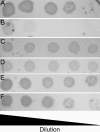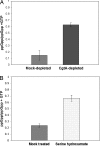Regulation of the stringent response is the essential function of the conserved bacterial G protein CgtA in Vibrio cholerae
- PMID: 17360576
- PMCID: PMC1838653
- DOI: 10.1073/pnas.0611650104
Regulation of the stringent response is the essential function of the conserved bacterial G protein CgtA in Vibrio cholerae
Abstract
The gene encoding the conserved bacterial G protein CgtA (Obg) is essential for viability in every organism in which it has been studied. CgtA has been reported to be involved in several diverse bacterial functions, including ribosome assembly, DNA repair, sporulation, and morphological development. However, none of these functions have been identified as essential. Here we show that depletion of CgtA in Vibrio cholerae causes global changes in gene expression that are consistent with induction of a classical low nutrient stress response or "stringent" response. We show that depletion of CgtA leads to increased ppGpp levels that correlate with induction of the global stress response and cessation of growth. The enzyme RelA is responsible for synthesis of the alarmone ppGpp during the stringent response. We show that CgtA is no longer essential in a relA deletion mutant and thus conclude that the essentiality of CgtA is directly linked to its ability to affect ppGpp levels. The enzyme SpoT degrades ppGpp, and here we show that SpoT is essential in a RelA+ CgtA+ background but not in a relA deletion mutant. We also confirmed that CgtA interacts with SpoT in a two-hybrid assay. We suggest that the essential function of CgtA is as a repressor of the stringent response that acts by regulating SpoT activity to maintain low ppGpp levels when bacteria are growing in a nutrient-rich environment.
Conflict of interest statement
The authors declare no conflict of interest.
Figures




Similar articles
-
G-protein control of the ribosome-associated stress response protein SpoT.J Bacteriol. 2007 Sep;189(17):6140-7. doi: 10.1128/JB.00315-07. Epub 2007 Jul 6. J Bacteriol. 2007. PMID: 17616600 Free PMC article.
-
Effect of a single amino acid substitution G98D in a ribosome-associated essential GTPase, CgtA, on the growth and morphology of Vibrio cholerae.Arch Microbiol. 2022 Sep 13;204(10):617. doi: 10.1007/s00203-022-03233-w. Arch Microbiol. 2022. PMID: 36097213
-
Genetic components of stringent response in Vibrio cholerae.Indian J Med Res. 2011 Feb;133(2):212-7. Indian J Med Res. 2011. PMID: 21415497 Free PMC article. Review.
-
Functional analysis of the essential GTP-binding-protein-coding gene cgtA of Vibrio cholerae.J Bacteriol. 2008 Jul;190(13):4764-71. doi: 10.1128/JB.02021-07. Epub 2008 May 2. J Bacteriol. 2008. PMID: 18456812 Free PMC article.
-
(p)ppGpp and the Stringent Response: An Emerging Threat to Antibiotic Therapy.ACS Infect Dis. 2019 Sep 13;5(9):1505-1517. doi: 10.1021/acsinfecdis.9b00204. Epub 2019 Jul 22. ACS Infect Dis. 2019. PMID: 31287287 Review.
Cited by
-
(p)ppGpp, a Small Nucleotide Regulator, Directs the Metabolic Fate of Glucose in Vibrio cholerae.J Biol Chem. 2015 May 22;290(21):13178-90. doi: 10.1074/jbc.M115.640466. Epub 2015 Apr 16. J Biol Chem. 2015. PMID: 25882848 Free PMC article.
-
Biochemical and physiological characterization of the GTP-binding protein Obg of Mycobacterium tuberculosis.BMC Microbiol. 2011 Feb 25;11:43. doi: 10.1186/1471-2180-11-43. BMC Microbiol. 2011. PMID: 21352546 Free PMC article.
-
Saccharomyces cerevisiae Rbg1 protein and its binding partner Gir2 interact on Polyribosomes with Gcn1.Eukaryot Cell. 2009 Jul;8(7):1061-71. doi: 10.1128/EC.00356-08. Epub 2009 May 15. Eukaryot Cell. 2009. PMID: 19448108 Free PMC article.
-
Restricting conformational flexibility of the switch II region creates a dominant-inhibitory phenotype in Obg GTPase Nog1.Mol Cell Biol. 2007 Nov;27(21):7735-44. doi: 10.1128/MCB.01161-07. Epub 2007 Sep 4. Mol Cell Biol. 2007. PMID: 17785438 Free PMC article.
-
YbiB: a novel interactor of the GTPase ObgE.Nucleic Acids Res. 2023 Apr 24;51(7):3420-3435. doi: 10.1093/nar/gkad127. Nucleic Acids Res. 2023. PMID: 36864742 Free PMC article.
References
Publication types
MeSH terms
Substances
Associated data
- Actions
Grants and funding
LinkOut - more resources
Full Text Sources
Molecular Biology Databases

